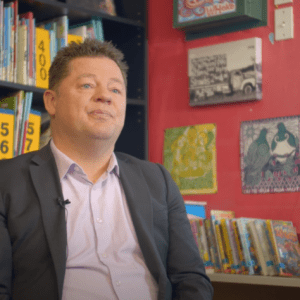Sose Annandale doesn’t want to talk about online learning. Not straight-off, anyway. The principal of Russell School in Porirua hears the cacophony of chatter about remote online learning as the new school term looms. Her inbox is crammed with advertisers hawking technology and software. But first up, she talks about families.
“Of course curriculum delivery is important and online provision is part of that, but in these times our first concern has to be the wellbeing of the families we work for.”
“In these times our first concern has to be the wellbeing of the families we work for.”
Sose Annandale
Many Russell School families are already vulnerable and the impact of the Covid-19 pandemic will be felt hard. That’s why the school’s first focus over the coming weeks has to be a pastoral one: making sure that families have food, are accessing services they need and that children are safe.
“A whole lot of wrap-around has to happen. We look at children not as individuals, but as members of a whole family, so that’s how we are organising our approach over this lockdown,” says Annandale.
The learning packs the teachers have made up for distribution are family packs, rather than for individual students, and each family has a single teacher who will support them and their children’s learning.
“When we started to look at how we would respond to this new reality, we went straight to our school vision and values,” says Annandale. “In our interactions with families, in what we send them or put online in the form of activities, our values have to be central.”
Russell School’s approach echoes the advice of NZ Principals’ Federation President, Perry Rush. In a newsletter to principals, he reminded them that technology is not a pedagogy.
“Pedagogy begins with your vision, your values and finds expression in your local curriculum,” he wrote. “The important question is not what online learning resource is best for you, but how technology might support your kaupapa; your school’s approach to learning.”
When Annandale turns to discussion of remote, online learning during the lockdown, she addresses the digital divide. That inequity has never been so starkly felt in Aotearoa.
Russell School is currently gathering data about devices and connectivity from its families, but Annandale knows that delivering curriculum online will be problematic. Only 17 of Russell School families have purchased Chromebooks through the Mana o Kupe Trust and the school itself has a limited stock. Schemes like Spark Jump can help to get households connected cheaply, but the economic toll of the lockdown is already biting deep. What’s more, families are not well placed to support children’s learning. Many parents have limited English or are recent arrivals with little understanding of the New Zealand Curriculum.
“Parents aren’t teachers and we don’t expect them to be.”
Sose Annandale
“Parents aren’t teachers and we don’t expect them to be,” says Annandale. “So we plan to make our teachers available by phone, messaging or email each morning. That will be the time when they’ll be giving individual family support. Afternoons will be spent on preparation, assessment, team meetings – you name it.”
*

In the early days of Covid-19, principal Karl Vasau and his senior staff at Rowandale Primary began developing plans for the possibility of remote learning. When the Prime Minister made her 24 March announcement of a move to level 4 and school shutdown, the Manurewa school was well down the track to preparedness.
“We had already set up our online learning site and started to populate it,” says Vasau. “We’d also met in teams to plan activities that would go in our home-learning packs.”
When parents came to pick up children on the day of the announcement, the [home-learning] packs were ready to go.
So when parents came to pick up children on the day of the announcement, the packs were ready to go. At the same time, families with the requisite technology were told how to access the school’s home learning site, where there were additional activities for students.
“We made sure that the activities we made available were ones our kids were familiar with; things like Mathletics and Reading Eggs and Class Dojo,” says Vasau. “There was more than enough to keep children occcupied in those last three days of term.”
Meanwhile, by word of mouth, newsletter, Facebook and text, parents received the most critical message: enjoy the break, stay safe and await the official launch of the school’s home-learning programme on 15 April.
In preparation, week two of term break was designated for teachers to meet virtually and adapt their learning programmes for a remote online platform. Meanwhile, Vasau and his senior management team set about trying to cobble together an infrastructure that would allow all students access. It was a complex job. Rowandale is a poor community – Decile 1a in old-school parlance. The digital divide that governments have spent years trying to span now had to be bridged in a couple of weeks.
The digital divide that governments have spent years trying to span now had to be bridged in a couple of weeks.
The school contacted families and gathered data. They learnt who had devices, what sort and how available these were to children. The information that came in was surprising: only eight percent of homes had no connection to the internet. Nevertheless, 260 families didn’t have a device that could be used for children’s learning.
“We have about 150 devices at school that we can roll out and we’ve being looking at how we can do that,” says Vasau.
The Ministry of Education has agreed that provided the school comes up with a plan that complies with Ministry of Health guidelines, the devices can be prepared and distributed so students can engage with Rowandale School’s home-learning site.
Vasau acknowledges that the school is undertaking a difficult task. The logistics of getting families set up with the technology are complicated and there’s likely to be plenty of troubleshooting required.
“As it is, our school server can be temperamental,” laughs Vasau. “When it goes down on a busy day, it can be like World War 3 has broken out.”
He’s hopeful that the Ministry of Education might help with the school network and also make up the shortfall in devices and connectivity, through N4L.
In Porirua, Annandale sees the opportunities as well. She knows that the next weeks and months will be new and difficult for teachers. But she also sees the disruption as an opportunity to listen very hard to the voices of children and parents.
“Their voices will help us navigate through,” says Annadale. “This lockdown probably won’t be the last challenge we face, but it gives us a chance to take a fresh look at what learning is and how we can make it happen.
“This is also a real chance for our whole system to seriously address the issue of equity.”



